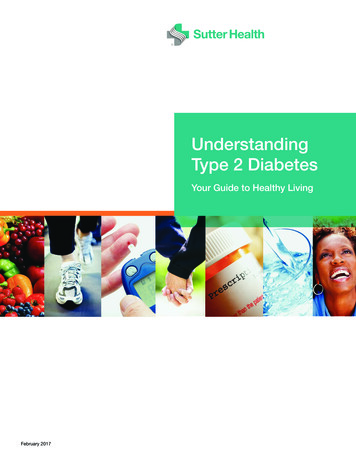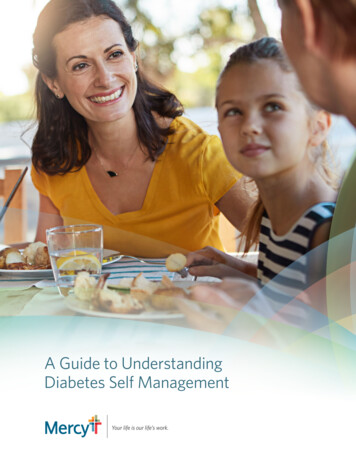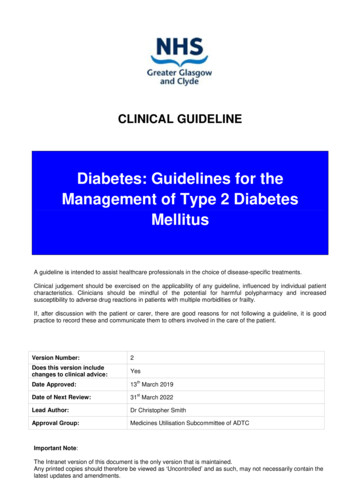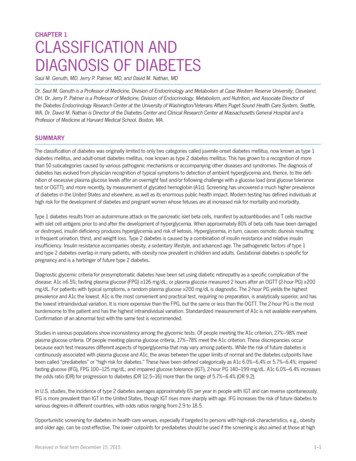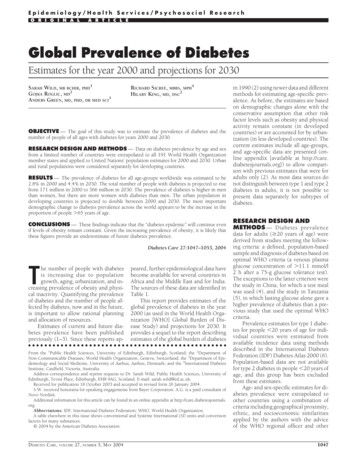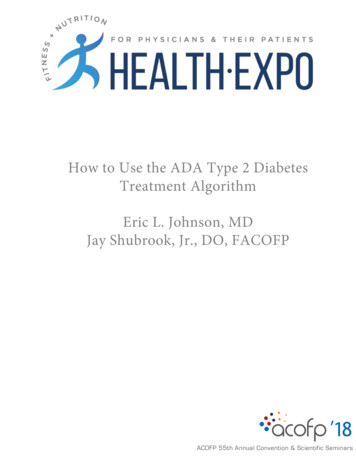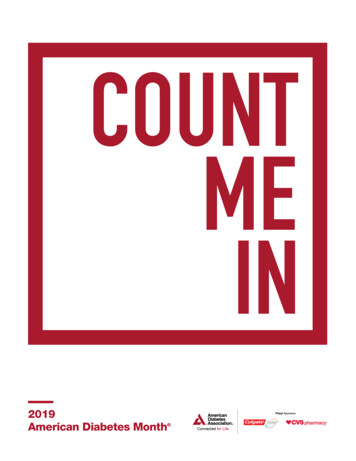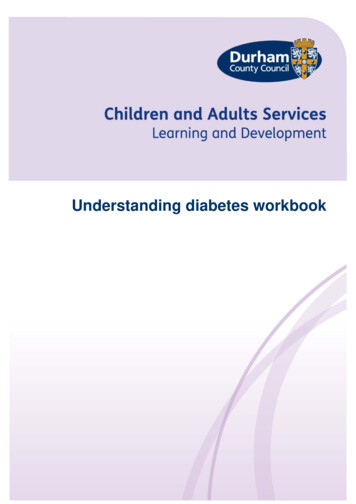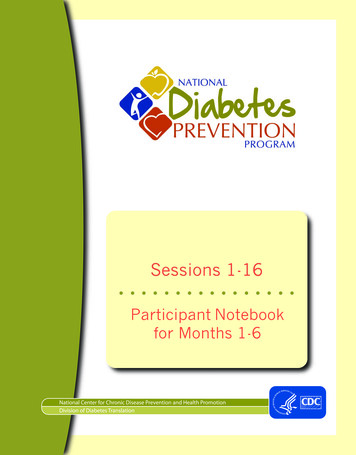
Transcription
Sessions 1-16 Participant Notebookfor Months 1-6
Session 1: Welcome to the National Diabetes Prevention ProgramLifestyle InterventionThe National Diabetes Prevention Program Lifestyle Intervention curriculum is based on the curriculumfrom the Diabetes Prevention Program (DPP) research study supported by the National Institutes ofHealth, National Institute of Diabetes and Digestive and Kidney Disease, Cooperative Agreement U01DK48489*. The DPP lifestyle intervention has been further adapted by: Plan Forward (University ofIndiana) and Group Life Balance (University of Pittsburgh). Certain concepts in the NationalDiabetes Prevention Program Lifestyle Intervention curriculum are adapted from these sources. Bothadaptations are derived from the DPP research trial supported by the Department of Health and HumanServices which has certain rights in the materials.*Copyright 1996 by the University of Pittsburgh, developed under cooperative agreement number U01-DK48489 by theU.S. Department of Health and Human Services, which has certain rights in the material.National Diabetes Prevention Program1
Session 1: Welcome to the National Diabetes Prevention ProgramSession 1: OverviewWelcome!You are here because you want to reduce your risk for type 2 diabetes, andwe’re glad to have you.We will work together toward two goals:Losing weight.Being more active.You’ll lose 7% of your weight through healthy eating and 150 minutes of briskphysical activity each week.Reaching Goals TogetherWe will meet for one year. Once a week for the next 16 weeks, then once amonth.Reaching your goal weight may prevent you from getting type 2 diabetes orheart disease. You will look and feel better. Your health will improve.National Diabetes Prevention Program2
Session 1: Welcome to the National Diabetes Prevention ProgramSession 1: Overview (continued)Getting Started withWeight LossQuick FactThis week we will get startedwith our weight loss goal bymaking healthy choices andtracking everything we eatand drink every day.What is type 2 diabetes?Type 2 diabetes is a disease caused by havingtoo much sugar in our blood. The sugar inblood is called glucose, pronounced GLUEkose.Keeping track of your weightand what you eat is the mostimportant part of changingyour behavior. We will giveyou the tools and support tomake it easy!How do we get glucose?We get glucose from the food we eat. Ourbody breaks down all the sugar and starch weeat into glucose. Glucose is the basic fuel forthe cells in our body.You Can Do It!We know that change is noteasy, but we are here to helpyou through it.You can make healthy choicesthat will reduce your risk fortype 2 diabetes. Together wewill take it one step at a time.You Can Do It!How do we get too much glucose in our blood?Normally our bodies use a hormone calledinsulin to carry the glucose in our blood tothe other cells in our body. The amount ofglucose in our blood can get too high for tworeasons: 1) our body does not have enoughinsulin or 2) our body does not use insulinproperly.What happens when the glucose in our blood getstoo high?The glucose builds up in the blood instead ofgoing into the cells, and we get diabetes.Diabetes can damage many parts of the body,including the heart, eyes, kidneys, andnerves.How can we stop ourselves from getting type 2diabetes?Participating in a lifestyle intervention to losesome weight and become more active canprevent diabetes.National Diabetes Prevention Program3
Session 1: Welcome to the National Diabetes Prevention ProgramHow Am I Doing? Sample ChartNational Diabetes Prevention Program4
Session 1: Welcome to the National Diabetes Prevention ProgramProgram Meeting ScheduleMeeting LocationRegular Meeting Day and TimeSession DateSession TitleWeek 2Welcome to the National Diabetes PreventionProgramBe a Fat and Calorie DetectiveWeek 3Reducing Fat and CaloriesWeek 4Healthy EatingWeek 5Move Those MusclesWeek 6Being Active: A Way of LifeWeek 7Tip the Calorie BalanceWeek 8Take Charge of What’s Around YouWeek 9Problem SolvingWeek 10Four Keys to Healthy Eating OutWeek 11Talk Back to Negative ThoughtsWeek 12The Slippery Slope of Lifestyle ChangeWeek 13Jump Start Your Activity PlanWeek 14Make Social Cues Work for YouWeek 15You Can Manage StressWeek 16Ways to Stay MotivatedWeek 1Your Lifestyle Coach’s name:Phone number(s):Best time to call:Email:Phone number of meeting site:National Diabetes Prevention Program5
Session 1: Welcome to the National Diabetes Prevention ProgramMeeting GuidelinesMeeting in a group can be a source of support and learning for all of us. Here are someguidelines for working together as a group:1. Do not repeat anything personal that you hear at the meeting to peopleoutside the group. We all want to share our experiences without beingjudged or afraid that our personal stories will be told to others.2. Be on time to the group meetings.3. Call the Lifestyle Coach 24 hours in advance if youcannot attend a meeting.4. Take part in sharing your ideas with other groupmembers.5. Let one person speak at a time.6. Let everyone have a chance to share. Be careful not totalk for too long.7. Be willing to listen to other people's concerns andrespect other people's ideas.8. Be positive and stress the good things.9. Do not use insulting phrases. Do not put others down.10. Complete the things you are supposed to do at home. Homework outside thegroup meetings is the most important factor in your success.National Diabetes Prevention Program6
Session 1: Welcome to the National Diabetes Prevention ProgramDiabetes Prevention Program (DPP)What is the Diabetes Prevention Program?The original Diabetes Prevention Program (DPP) was a research study funded by theNational Institutes of Health (NIH) and supported by the Centers for Disease Controland Prevention (CDC). The results showed that making certain lifestyle changes andcontinuing them over time can prevent type 2 diabetes in people who are at risk.Who took part in the research study?More than 3,000 adults took part. They came from 27 locations around the United States.Everyone in the study had prediabetes. Prediabetes means that blood sugar ishigh but not yet high enough to be type 2 diabetes.Nearly half of the people in the study were African Americans, Hispanics,American Indians, Asians, or Pacific Islanders. People of these racial or ethnicgroups are at high risk for type 2 diabetes.2 out of 10 were 60 years old or older. People older than 60 are at higher risk thanyounger people.The average starting weight of the people in the study was 207 pounds.How did the researchers do the study?Each person in the study was randomly assigned to one of three treatment groups:Lifestyle change: The 1000 people in the lifestyle group focused on losing weightand being more active. They did not receive any medication.Medication: The 1000 people in the medication group were given metformin.Metformin is a medication used to treat diabetes. The group did not focus onlosing weight or being more active.No treatment: The 1000 people in the placebo group got no medication and werenot asked to change their lifestyle.National Diabetes Prevention Program7
Session 1: Welcome to the National Diabetes Prevention ProgramDiabetes Prevention Program (continued)What happened?The group was studied for about 3 years, and these were the results for each group:Lifestyle change: Participants cut their risk for type 2 diabetes by 58%. Peopleolder than 60 cut their risk by 71%.Medication: Participants cut their risk for type 2 diabetes by 31%.No treatment: Participants had no change in their risk for type 2 diabetes.Research Study ResultsThe research study and many later studies showed that lifestyle changes are best atpreventing type 2 diabetes. Because of that finding, many programs, like this one,have been set up throughout the United States and the world.Research studies and personal experiences continue to show the success of thisprogram. It helps people lose weight, remain active, and delay or preventtype 2 diabetes.Our goalThis program is based on the DPP study and many others that have been conductedsince.Our program will help you Learn the facts about healthy eating and being active.Learn what makes it hard for you to eat healthy and be active.Learn how to change your habits to healthier habits.Maintain the long-term support you need to stick with the changes.National Diabetes Prevention Program8
Session 1: Welcome to the National Diabetes Prevention ProgramProgram GoalsWe will work toward a healthy balance between two parts of your lifestyle: How much you eat. How active you are.By achieving a healthy balance, you can reduce your risk for type 2 diabetes.Therefore, this lifestyle intervention has two important goals for you:Program Goals1. Lose weight through healthy eating.2. Be more physically active.Studies show that making these lifestyle changes andcontinuing them over time can help to prevent type 2diabetes in people who are at risk.National Diabetes Prevention Program9
Session 1: Welcome to the National Diabetes Prevention ProgramProgram Goals (continued)This program has been carefully designed to help people change their lifestyle. Inthis program you will learn: Facts about healthy eating and being active. Why it is hard for you to eat healthy and be active. How to change some habits so that new habitswork for you, not against you.For example, you will learn how to — Find the time to be active. Ask for what you want when you go out to eat. Keep things around you at home and at work thatmake you want to be active and eat healthy. Get rid of things that get in your way or cause you tolose your healthy balance. Replace negative thoughts with positive ones. Get back on your feet if you slip from your plansfor healthy eating and being active. Handle stress, social events, and other people thatmake it hard for you to change.I will give you the support you need. I will be your Lifestyle Coach.National Diabetes Prevention Program10
Session 1: Welcome to the National Diabetes Prevention ProgramProgram Goals (continued)This program has set weight loss and physical activity goals thatwill reduce your risk for type 2 diabetes, but only if you follow them. Lose 7% of your weight through healthyeating.Your goal will be to weigh pounds or less.minutes of brisk physical activity Doeach150week.Example: Take a brisk walk for 30 minutes, five days a week.The program’s goals are safe and can be reached.Even small changes can have big rewards for your health.We will help you reach your goals by making gradual, healthy,and reasonable changes in your eating and activity.National Diabetes Prevention Program11
Session 1: Welcome to the National Diabetes Prevention ProgramGoal WeightsThis chart shows starting weight and goal weight with a 7% loss. Find yourcurrent weight, and then your goal weight to achieve during this program.Starting Weight: Goal Weight:120-199 lbsYourStartingWeight(pounds)Your GoalWeight(pounds)YourStartingWeight(pounds)Your GoalWeight(pounds)YourStartingWeight(pounds)Your tional Diabetes Prevention Program12
Session 1: Welcome to the National Diabetes Prevention ProgramGoal Weights (continued)200-299 lbsYour StartingWeight(pounds)Your GoalWeight(pounds)Your StartingWeight(pounds)Your GoalWeight(pounds)Your StartingWeight(pounds)Your 266247233217267248National Diabetes Prevention Program13
Session 1: Welcome to the National Diabetes Prevention ProgramGoal Weights (continued)300-399 lbsYour StartingWeight(pounds)Your GoalWeight(pounds)Your StartingWeight(pounds)Your GoalWeight(pounds)Your StartingWeight(pounds)Your 366340333310367341National Diabetes Prevention Program14
Session 1: Welcome to the National Diabetes Prevention ProgramGoal Weights (continued)400-499 lbsYour StartingWeight(pounds)Your GoalWeight(pounds)Your StartingWeight(pounds)Your GoalWeight(pounds)Your StartingWeight(pounds)Your 459460461462463464National Diabetes Prevention Program15
Session 1: Welcome to the National Diabetes Prevention ProgramWe Will Work Together As a TeamThroughout this program, you will rely on the group in differentways to learn and grow.I will count on you to do the items listed below: Come to sessions and bring your Participant Notebook. Call 24 hours ahead if you must miss a session. Do your best to reach your eating and activity goals. This includes doinghome activities to practice what you learn. Keep track of your eating and activity 7 days a week. Be honest. Keep track of your weight at home. Let me know if you have any problems by calling or e-mailing me. Stay willing and open to change. Always hang in there.You can count on your Lifestyle Coach and the group to do the items listedbelow: Notice what you are doing well and what can be improved. Answer your questions; share solutions and ideas, while learning together. Be honest. Stand by you during hard times. Believe you can reach your eating and activity goals. Support and help you always. The group will hang in there with you.We agree to work together in the ways described above.Signed SignedParticipantNational Diabetes Prevention ProgramLifestyle Coach16
Session 1: Welcome to the National Diabetes Prevention ProgramRemember Your PurposeTake a moment to respond to these questions in the space provided below.Why did I join this program?What do I hope to achieve by taking part in this program?How will healthy eating and being active help me and others?National Diabetes Prevention Program17
Session 1: Welcome to the National Diabetes Prevention ProgramKeeping TrackStart keeping track of what you eat and drink each day.Write down everything you eat and drink.It's the most important part of changingyour behavior. Spelling is not important.What is important is to— Be honest. Write down what you really eat. Be accurate. Measure portions, and read labels. Be complete. Include every little scrap you eat.National Diabetes Prevention Program18
Session 1: Welcome to the National Diabetes Prevention ProgramKeeping Track: Practice Page (continued)Food and Drink Total:National Diabetes Prevention Program19
Session 1: Welcome to the National Diabetes Prevention ProgramTo-Do Next WeekDuring the next week, I will — Write down every little thing I eat and drink every day. Include the time when I eat each item. Include the amount of food, the name of the food, and adescription. Skip the other columns for now. Use one line for each food. For example, instead of writing“sandwich,” write all the things that are in the sandwich,one on each line.2 slices whole wheat bread1 slice American cheese1 slice turkey1 tsp mayonnaise“Toast with butter” should be on two different lines:1 slice whole wheat toast1 tsp butter Circle the foods or drinks I think are high in fat and calories. Bring my Food and Activity Tracker and Participant Notebook to the nextsession.National Diabetes Prevention Program20
Session 2: Be a Fat and Calorie DetectiveSession 2: OverviewBe a Fat and Calorie DetectiveReducing the fat and calories in our meals is one of the most importantsteps we can take to improve our health. To reach healthy eating goals, weneed to track our weight and how much we eat. Our role as a “fat andcalorie detective” is to find the high-fat, high-calorie foods in our mealsand figure out ways to make them healthier.Monitor Our Food and WeightMonitoring what we eat is a smartway of making sure we makehealthy choices. Monitoring whatwe do is the most important part ofchanging our behavior. Therefore,an important part of this programis to write down everything you eatand drink in your Food and ActivityTracker.How Am I Doing?Use the How Am I Doing? weightchart to track your weight at homeand before each session. This chartis important because it shows howyour weight is changing over time.National Diabetes Prevention ProgramQuick FactWhy does it matter if I get type 2diabetes?People with diabetes are twice aslikely as people without diabetesto die early.The good news is that by makingsmart choices in eating andphysical activity, you can delay orprevent type 2 diabetes.But there’s more good news. Evenwith diabetes, people can lowertheir chances of blindness, kidneydisease, heart attack, and stroke byeating healthy and getting regularphysical activity.1
Session 2: Be a Fat and Calorie DetectiveYour Fat Gram GoalEveryone is different, and we each have different needs. So each of you will beassigned a number of daily fat grams. That number is your budget of fat gramsper day.We will base the number of fat grams assigned to you on your present weight andweight loss goal of 7%. And, of course, we will help you to keep track and writedown the foods you eat to stay within this budget. You will use the Fat and CalorieCounter to help you figure out what to eat and the right amounts to eat.For Next WeekNext week will be exciting because you will be taking the first key steps towardchanging how you live. You are now beginning to improve your health andreduce your chances of getting type 2 diabetes.National Diabetes Prevention Program2
Session 2: Be a Fat and Calorie DetectiveBe a Fat and Calorie DetectiveAll about FatTo help you lose weight, we will begin building healthy eating habits. Here are somefacts about fat and calories to get you started: Healthy eating means eating less fat and fewer calories. Eating too much fat is what makes us fat. By eating less fat, you can lose weight. Fat has the most calories of all the foods we eat. Fatcontains more than twice the calories as the sameamount of sugar, starch, or protein. Even small amounts of high-fat foods are high in calories.Compare Peanuts with PopcornFoodAmountGrams of FatCaloriesPeanuts¼ Cup19215Popcorn3 cups plain, air popped(12 times as much food!)090Note: Peanuts are high in fat, but they are a healthy choice if you eat them in small amounts.National Diabetes Prevention Program3
Session 2: Be a Fat and Calorie DetectiveWhat High Fat Foods Do You Eat?Using last week’s Food and Activity Tracker, list the kinds of foods you eat that are highin fat or calories.1.2.3.4.5.6.7.8.9.10.Quick FactAlmost three-quarters of the fat we eat ishidden in the food! We can’t see it.National Diabetes Prevention Program4
Session 2: Be a Fat and Calorie DetectiveSample Lunch MenuLook at this example of a typical lunch at a fast food restaurant. Noticethe amount of fat and calories.FoodFat GramsTeaspoonsof FatFried fish sandwich195411Large French fries226437Apple Turnover, fried154288Milkshake, with icecream18534674201,482TotalCaloriesNote: These are estimates. The actual amount of fat and calories vary by brand.National Diabetes Prevention Program5
Session 2: Be a Fat and Calorie DetectiveTracking Fat and CaloriesKeeping track of fat is important. Just follow the steps below.1 Look at the chart on the next page. It shows the number of fatgrams you can eat each day and still lose weight.2 Write down everything you eat and drink. Be honest. Itdoesn’t work if you’re not completely honest.3 Figure out how many fat grams are in everything you eatand drink. Measure the amount you eat and the amount you drink. Look up each item in the Fat and Calorie Counter. Write down the amount of fat and calories in each itemthat you eat or drink.4 Add up the fat grams you eat and drink during the day. Try toeat only the number that you can have each day and still loseweight.National Diabetes Prevention Program6
Session 2: Be a Fat and Calorie DetectiveFat Gram GoalUse this chart to figure out the number of fat gramsyou can have each day.Try to eat only the number beside your weight.Your Starting Weight(pounds)Fat Gram Goal174 pounds or less33175 to 21942220 to 24950250 to 29955300 pounds or more55Quick Fact1 pound of fat 3,500 caloriesThis means that if you want to lose 1 or 2 pounds each week, eatbetween 500 and 1,000 fewer calories every day.National Diabetes Prevention Program7
Session 2: Be a Fat and Calorie DetectiveFat and Calorie Counter GuidelinesHere are some tips for getting the most out of the Fat and Calorie Counter.Problems finding a food? If a food is not listed, use the fat gram and calorie values for a food thatis the closest to it. For example, use banana bread for zucchini bread. Write the name of the food in the back of your Fat and Calorie Counter,and ask your Lifestyle Coach about it next week.Having trouble figuring out fat grams and calories? Write down the food or drink and the amount you ate. Your Lifestyle Coach will help you next week.How to measure the fat and calories in recipes? Add up the fat grams of each ingredient in the recipe, anddivide the result by the number of people the entire recipewill serve. The answer is the number of fat grams in eachserving. In the same way, you can calculate the number ofcalories in each serving. If you can’t find an ingredient in the Fat and Calorie Counter, find aningredient that is like the one in your recipe. Write down the fat gramsand calories in that ingredient as a substitute for the one you can’t find. If you often cook from recipes, bring a favorite recipe next week. YourLifestyle Coach will help you count the grams of fat.National Diabetes Prevention Program8
Session 2: Be a Fat and Calorie DetectiveAdding Up Fat GramsTimeAmountNational Diabetes Prevention ProgramFoodName/DescriptionGrams ofFat9
Session 2: Be a Fat and Calorie DetectiveEating Packaged FoodsThis is a sample of a nutrition label that you see on many packaged foods. Thislabel shows information about the fat, calories, and other nutrients in the food.Find the serving size, and decide ifthat is the amount you ate. Maybeyou ate more or less.Find the calories per serving.Find the total fat grams per serving.Keep this in mind:If you eat a larger serving than thesize on the label, you will be eatingmore calories and more fat gramsthan are given on the label.National Diabetes Prevention Program10
Session 2: Be a Fat and Calorie DetectiveTo-Do Next WeekDuring the next week, I will — Keep track of my weight in the Food and ActivityTracker Weigh myself at home every day, or every fewdays, at this time of day . Record my weight on the back of the Food andActivity Tracker. Keep track of what I eat and drink Write down everything I eat and drinkin the Food and Activity Tracker. Use the Fat and Calorie Counter to figure out how much fat is in eachitem I eat. Write down the fat grams in the Food and Activity Tracker. Keep a running fat gram total throughout the day. Come as close to my fat gram goal as I can.National Diabetes Prevention Program11
Session 3: Three Ways to Eat Less Fat and Fewer CaloriesSession 3: OverviewWeighing and Measuring FoodWeighing and measuringfood are important waysof knowing what we eat.Measuring helps usmake healthierchoices.Eating even a slightlysmaller amount canmake a big difference infat grams and calories.Many people feel theydo not need to weigh ormeasure their foodbecause they thinkthey know how much they eat. But mostof us are surprised when we actually domeasure. Our eyes can play tricks on us!Quick FactEating too much fat can causeheart disease and type 2diabetes.Eating a lot of fat can increasethe amount of cholesterol in ourblood.The higher our cholesterol, thegreater our chances of having aheart attack.Eating a lot of fat also increasesour chances of getting type 2diabetes.Estimating Fat and Calorie ContentIt is hard to know the amount of fat and calories in our food, but withpractice, we can make a good guess.National Diabetes Prevention Program1
Session 3: Three Ways to Eat Less Fat and Fewer CaloriesEating Less Fat and Fewer CaloriesIn this program, we will learn three ways to help us eat less fat and fewercalories. We will —Eat high-fat and high-calorie foods less often.Eat smaller amounts of high-fat and high-calorie foods.Eat low-fat and low-calorie foods instead of high-fat, high-caloriefoods.Menu MakeoversChoosing low-fat and low-sugar foods will help you reduce the fat andcalories you eat.National Diabetes Prevention Program2
Session 3: Three Ways to Eat Less Fat and Fewer CaloriesMeasurement BasicsMeasurementAbbreviationEquivalentCupc8 ounces or 16tablespoonsTablespoonT or Tbsp3 teaspoonsTeaspoont or tspThe amount in a regularsize spoonOunceoz28 gramsGramgThe weight of a paper clipNational Diabetes Prevention Program3
Session 3: Three Ways to Eat Less Fat and Fewer CaloriesTips for Weighing and Measuring FoodWeighing and measuring foods is important for keeping track of howmuch you eat. Use the following tips to figure out the most exactamount.Use a metal or plastic measuring cup for solid foods. Fill and level off the ingredient before you write downthe amount.Use a glass measuring cup for liquids. Read the line showing how much is in the cup at eyelevel.Use a scale for meat, fish, cheese, bread, pasta, rice. Weigh meat after it is cooked. Remove the fat and bone before you weigh meat or fish. Remember: 4 oz of raw meat equals 3 oz cooked meat. 3 oz is about thesize of a deck of cards.Use measuring spoons for both solids and liquids. Level off solid ingredients before you write down the amount.National Diabetes Prevention Program4
Session 3: Three Ways to Eat Less Fat and Fewer CaloriesGuess What?Most people are surprised when they weigh and measure food. We’re now going to doan exercise. For this exercise, follow these steps to guess the amount of food shown.1. Write down the name of each food on display.2. Guess the amount using cups, tablespoons, teaspoons, ounces, or grams.3. Weigh or measure the food. Write down the actual amount.4. Figure out the fat grams and calories for the actual amount.FoodNational Diabetes Prevention ProgramGuessedAmountActualAmountFatGramsCalories5
Session 3: Three Ways to Eat Less Fat and Fewer CaloriesThree Ways to Eat Less Fat andFewer CaloriesIn this session, we discuss three simple ways to eatless fat and fewer calories.1. Eat foods high in fat or calories less often.Example: Eat French fries once a week instead ofevery day. That would mean about 132 fewergrams of fat per week!2. Eat smaller amounts of high-calorie foods. Cutting back even a little on theamount you eat can make a big difference.Example: At the salad bar, use a regular spoon instead of the ladleto pour on salad dressing. Most ladles hold 4 tablespoons, but mostspoons hold 1 tablespoon or less. So you’ll eat only a quarter of thefat. You’ll eat 24 fewer grams of fat!3. Eat lower-fat and lower-calorie foods instead.Example: Choose non-fat milk instead of whole milk.National Diabetes Prevention Program6
Session 3: Three Ways to Eat Less Fat and Fewer CaloriesThree Ways to Eat Less Fat and FewerCalories (continued)Use the table below to help you find examples of lower-fat and lower-calorie foods.Instead of this food:Fat(g)CaloriesChoose thisfood:Fat(g)CaloriesPotato chips,1-ounce bag11161Pretzels,1-ouncebag1108Regular margarine,1 tsp434Low-fatmargarine,1 tsp2174153Roast beef(chuck),untrimmed,3 ounces22286Roast beef (topround),trimmed,3 ouncesBaked potato with2 Tbspsour cream656Baked potatowith2 Tbsp salsa08439Chicken breastwithout skin,grilled9205Chicken breast,with skin, breaded,fried24Warning: Low-fat or fat-free products often contain a lot of calories.For example —½ cup low-fat frozen yogurt can have between 110- 180 calories.Some low-fat or fat-free products are very high in calories because they’re loadedwith sugar. Be careful. Ch
Jump Start Your Activity Plan Make Social Cues Work You Can Manage Stress . National Diabetes Prevention Program . 5 . Session 1: Welcome to the National Diabetes Prevention Program . Best time to call: Program M


